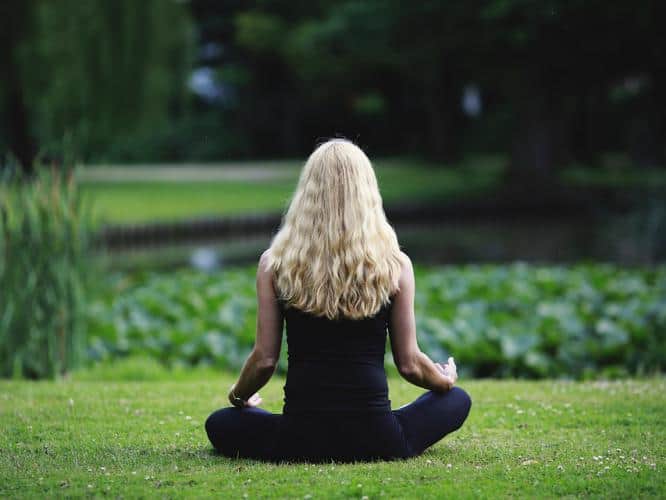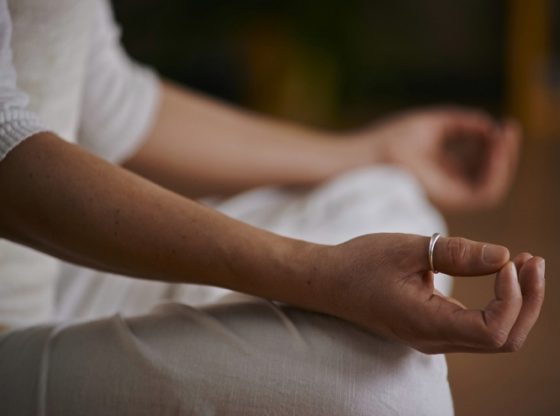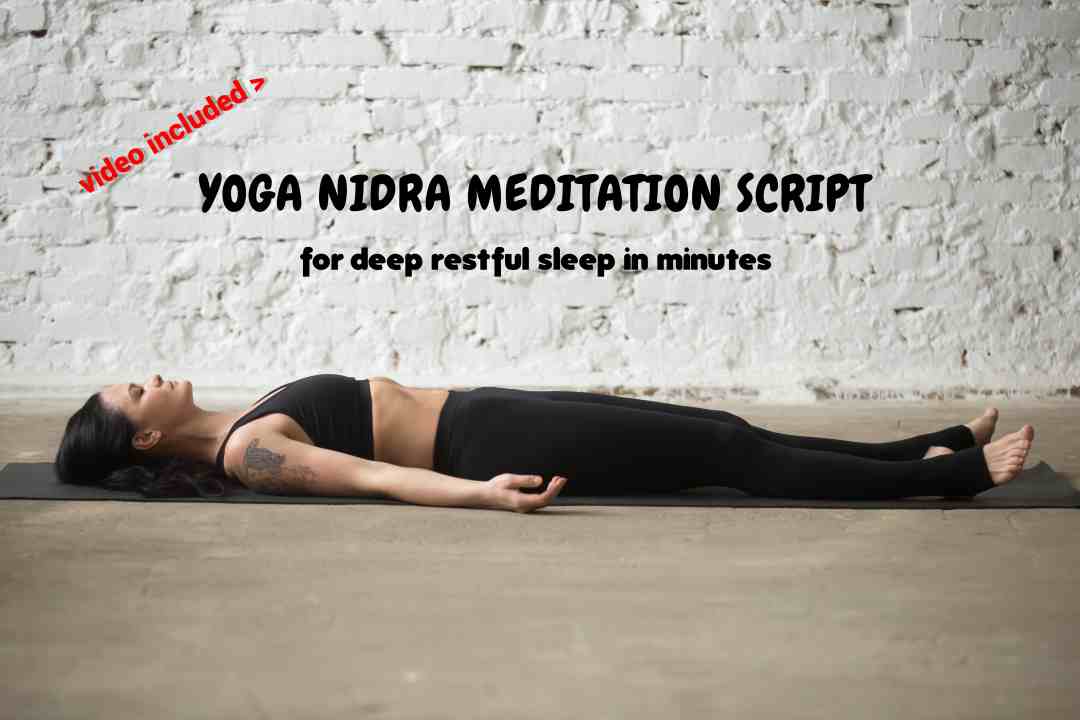Mindfulness Meditation is two words that are mirror-like reflections of each other. They are usually mistaken for the same meaning. However, Mindfulness, as we all know, is being fully aware of the present moment. Noticing and paying attention to feelings, thoughts, behaviour, and emotions. It can be practised anywhere and everywhere by being fully present in the now.
Whereas Meditation is a practice where you use a technique like mindfulness or focus on an object, activity or thought in order to train attention and awareness. Your objective is to attain a state of emotional calmness, stable state and becoming mentally clear.
Meditation comes in various forms from Chanting Mantra Meditation to Breathing Meditation, all aiming to relieve stress and anxiety.
Mindfulness is the awareness of “some-thing,” while Meditation is the awareness of “no-thing.” – Ed and Deb Shapiro
6 Steps to Practice Mindfulness Meditation:
Step 1: Find a Peaceful Spot
“The end of all our exploring Will be to arrive where we started And know the place for the first time.” – T.S. Eliot
Firstly, find a location either at home or outside among nature but without any distractions. Make sure the spot you choose to meditate is peaceful and where you can completely detach from the chatter in and around you. Moreover, try and meditate at the same spot each day.
Moreover, it is not necessary to keep a fixed time to meditate but using a prompt such as drinking your morning tea or coffee can push your body into the meditative mode. A signal to your brain that it is time to quiet the mind of yesterday and tomorrow’s worries.
In case you are travelling you may not find the same spot every day – Don’t worry!
5 Tips to Practice Yoga While Travelling – making it Irresistible

Step 2: Find a Comfortable Spot and Gear
To practice Mindfulness Meditation, you do not necessarily have to be in a stationary mode. You can meditate while sitting on a chair on an aeroplane or even walking.
But if you decide to practice meditation while sitting either cross-legged on the floor or on a chair, then make sure your posture is upright and not stiff. Place pillows under your hips to have comfortable seating. How to sit in Meditation Postures – Cross-legged or on a Chair
Also, wear very comfortable clothing that does not distract you with adjusting them all the time. Read the Ultimate Guide to Choosing Yoga Pants.
Where to keep your hands during Meditation?
Step 3: Become Aware of your Body
Corpse Pose helps loosen up those tensed muscles an increased awareness of my body. I always start my morning by doing Yoga Breathing, Yoga Poses and then lie down in Corpe Pose of Yoga. Actually, Corpse pose is just lying down and relaxing my mind, body and soul before I start Mindfulness Meditation.
It is the best practice!
“Mindfulness of the Body Leads to Nirvana.” – Lord Buddha
To be aware of the present, notice every body part. Notice your legs, loosen up your arms, soften your gaze, feel your muscles. Also, relax those stiff muscles around your shoulders and neck. Wiggle those toes and loosen them up. Don’t forget to unclench your jaw and relax those worry lines on your face. Lastly, relax your entire body and notice how stress-free your muscles and joints already begin to feel.
Corpse Pose in Yoga (Savasana or Shavasana) Steps and Benefits
http://wordpress-334546-1028402.cloudwaysapps.com/corpse-pose-yoga-savasana-shavasana-steps-benefits-wellnessworks/
Step 4: Pay Attention to your Intention
Start with a 10-minute time frame and increase it up to 30 minutes or whatever time permits. Moreover, pay attention to the reasons you started mindfulness meditation.
Reasons to practise mindfulness meditation may change each day – for instance:
- You want to get energized as you pre-empt and prepare for a long day ahead.
- To alleviate the negative feelings towards yourself or others or a circumstance.
- Or, you could be looking for improved cognitive skills as you do higher studies.
Only, if you do anything with an objective – it helps you become committed. Same goes for the practice of mindfulness meditation.
“Meditation means dissolving the inner wall that unawareness has built.” – Sadhguru
Step 5: Calm your Mind by Focusing on your Breath
Imagine your thoughts are like floating clouds – they keep coming in. Let them float in and out like clouds do and stop paying attention to your thoughts. Yes, thoughts will come to you, one after the other, however, will eventually reduce and finally stop coming to you. This becomes easier with practice. Thus, do not try and become perfect on the very first day.
“Put your thoughts to sleep, do not let them cast a shadow over the moon of your heart, let go of thinking.” – Rumi
Paying attention and being aware of your breath is a mindfulness practice. Feel the lungs and abdomen expand as you breathe in and release all negative emotions and dead cells in your body as you exhale. Bring your focus back to your breathing pattern. You may have to repeat this pattern several times before you actually get a hang of it. In the end, you will find that as you shift your attention, your thoughts will become calmer and so will you.
The two steps of Breathing while Meditating “steadies the ‘prana’ and quiets the mind.” Read the full blog on How I have broken down meditation in 12 Easy Steps for beginners
Another technique that I always practise while meditating is to focus on my third eye (centre between the two eyebrows) with my eyes shut. In case you cannot close your eyes – gaze at an object, candle, or a point in front of your eyes as you look straight ahead.
- If you are “predominantly intellectual” you could focus on the space between your eyebrows.
- For those of you who are “emotional”, you should visualize in the heart plexus.
Click here for the full article on 12 Steps to Mediate
Step 6: Let go of Control on your Mind – Focus on the Present
The first question most of my students ask is How to Control my mind during mindful meditation?
It is natural to feel curious before you start mindfulness meditation. Just like starting to learn a new language. Have an open mind without any preconceived notions.
The best way to mindfully meditate is not giving your mind and thoughts too much attention. Ajahn Brahm, Buddhist Monk from Perth Australia says – imagine the thoughts regarding your past filled in huge shopping bags. Try and keep the bags behind you on your left side – pausing them and letting them go. Further, fill all your thoughts about the future in more shopping bags and keep them behind you on your right side. Important is to let them be for the time you mediate. Most importantly, feel the weight of your mind lift off your shoulders.
Lastly, soak in and feel the present moment. Enjoy the breath on your upper lip as you deeply inhale and exhale. Tune in to the sound of birds chirping or chanting music playing in the background. Inhale the camphor or aroma candles you may have lit up to soothe your senses. Notice the distance buzzing of the traffic fade away, or how cold the bench under your bottoms is.
Similar to Corpse Pose, feel the areas of your body that may feel tense. Relax each body part one by one by sending them happy loving thoughts. Soon you will slip into a blissfully calm state.
Be Present Fully!
How to Disassociate from your Mind while meditating- Read Full article here
“Be Still. The Quieter you become the more you HEAR.” – Unkown
BOTTOM-LINE
There are scientific studies to prove why you feel relaxed or happy after mindfulness meditation practice. It releases happy chemicals in the brain, lowers blood pressure and inflammation and increases your creativity and cognitive ability. Also, just by altering the brain organs like Amygdala and Hippocampus – Mindful meditation reduces anxiety, cures depression and prevents Alzheimer’s.
Now, don’t’ you think learning to Mindfulness meditation is better than spending months and years in rehab when you grow older.
I am sure you agree!
Lord Buddha was asked,
“What have you gained from Meditation?”He replied, “Nothing!However, let me tell you what I lost; Anger, Anxiety, Depression, Insecurity, Fear and Death.”
Related Articles:
Read our article on How Meditation Changes the Brain – Studies and Facts
3 Ways to Chant Aum Om Properly
How to chant Mantra Meditation and Types of Chants
How to Speak Truth with Mindfulness
Mindful Eating Techniques for Weight Loss
Slow Down – Take Notice – Practice Mindfulness
How to Build Awareness on Listening Mindfully Every day
References:
https://www.verywellmind.com/mindfulness-meditation-88369
https://www.developgoodhabits.com/how-to-practice-mindfulness/
https://www.wikihow.com/Do-Mindful-Meditation
https://medium.com/thrive-global/mindfulness-meditation-whats-the-difference-852f5ef7ec1a
https://www.mindful.org/mindfulness-how-to-do-it/
https://blog.mindvalley.com/mindfulness-meditation/
https://www.bupa.co.uk/newsroom/ourviews/mindfulness-my-brain









